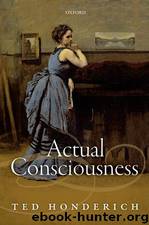Actual Consciousness by Ted Honderich

Author:Ted Honderich
Language: eng
Format: epub
Published: 2014-12-26T16:00:00+00:00
What Is Actual
You’ve heard what is actual in hearing of some, certainly not all, of what isn’t actual.
But, to make it official, what is actual with respect to my perceptual consciousness now is walls, a desk, drawings, shelves of books, the computer stuff, the clock and so on. You have heard of these, of course, as things, ordinary things, things around me in space, things having properties, unities of properties. These items are not merely seen, in any sense of the word contrived to describe experience unusally thought of. Rather, they are somehow seen as what they are.
What is actual, we can as well say, as we have, is a state of affairs, circumstance, fact, a thing having properties, things having properties, what is the case—all of which common terms or usages are not terms or usages for propositions, statements, reports, information, thoughts, or the like, but rather terms for what it is that makes propositions and the rest true or false. What is actual, to note the old ambiguity, is a fact where that is seen rather than told (cf. Austin, 1961a, 1961b; Peter Strawson, 1950).
Still, what that comes to is that with respect to the desk’s being actual, the rest of the story must somehow somewhere include the thought of a desk, an idea or a concept. Put into words or a word, maybe it is ‘my desk’, ‘that thing there’, or ‘it’. Maybe some thing or things much more specifically identified. Maybe the story includes what we can call an inner proposition, statement or utterance, maybe the minimal ‘What’s there is that’ or ‘That’s what’s included’.
But to say the story of my perceiving or perception, indeed a whole line of inquiry or research programme, has in it something of this sort, is definitely not to say something else. It is not to say that my being perceptual conscious, what is actual, what is given or presented or for something or immediate and so on, includes anything of this sort. I can start thinking about what I am visually conscious of, of course, maybe start attending to something. But if we stick to the seeing, what is had is not both a desk and a concept of a desk.
I’m not in any danger of reporting to you that my experience was in part, let alone was, like my experience of thinking about the concept of a desk, wondering what the primary ordinary use of the term is, what the dictionary will say, and so on. That happens when I’m on the way to the dictionary, not now.
It needs to be remarked, maybe, that any tendency to urge me to stick a concept into what is actual may be owed to a simple and familiar fact. To see is often to be about to think in another sense, to be on the verge. It is to attend to a particular thing of a property rather than others. Or it is to think about the thing or property—its familiarity, say, or its colour.
Download
This site does not store any files on its server. We only index and link to content provided by other sites. Please contact the content providers to delete copyright contents if any and email us, we'll remove relevant links or contents immediately.
| Anthropology | Archaeology |
| Philosophy | Politics & Government |
| Social Sciences | Sociology |
| Women's Studies |
The History of Sexuality: An Introduction: 1 by Michel Foucault(1294)
Ikigai by Yukari Mitsuhashi(930)
Catching the Big Fish by David Lynch(893)
The Doors of Perception and Heaven and Hell by Aldous Huxley(845)
The Origins And History Of Consciousness by Erich Neumann(829)
Wanderlust: A History of Walking by Rebecca Solnit(818)
Psicomagia by Alejandro Jodorowsky(751)
How the Mind Works by Steven Pinker(732)
Other Minds: The Octopus, the Sea, and the Deep Origins of Consciousness by Peter Godfrey-Smith(718)
Heaven and Hell by Aldous Huxley(697)
Self Comes to Mind by Antonio Damasio(694)
Happy by Derren Brown(693)
The Biology of Belief by Bruce H. Lipton(686)
Meeting the Shadow by Connie Zweig(671)
Knowledge Of The Higher Worlds And Its Attainment by Steiner Rudolf(669)
Touching a Nerve by Patricia Churchland(648)
Self Comes to Mind: Constructing the Conscious Brain by Damasio Antonio(637)
I Am a Strange Loop by Douglas R. Hofstadter(605)
How to Grow a Human by Philip Ball(605)
